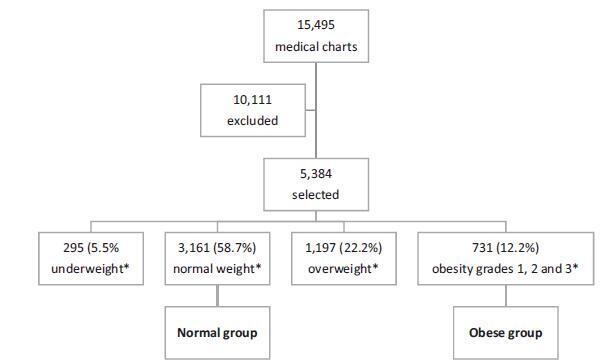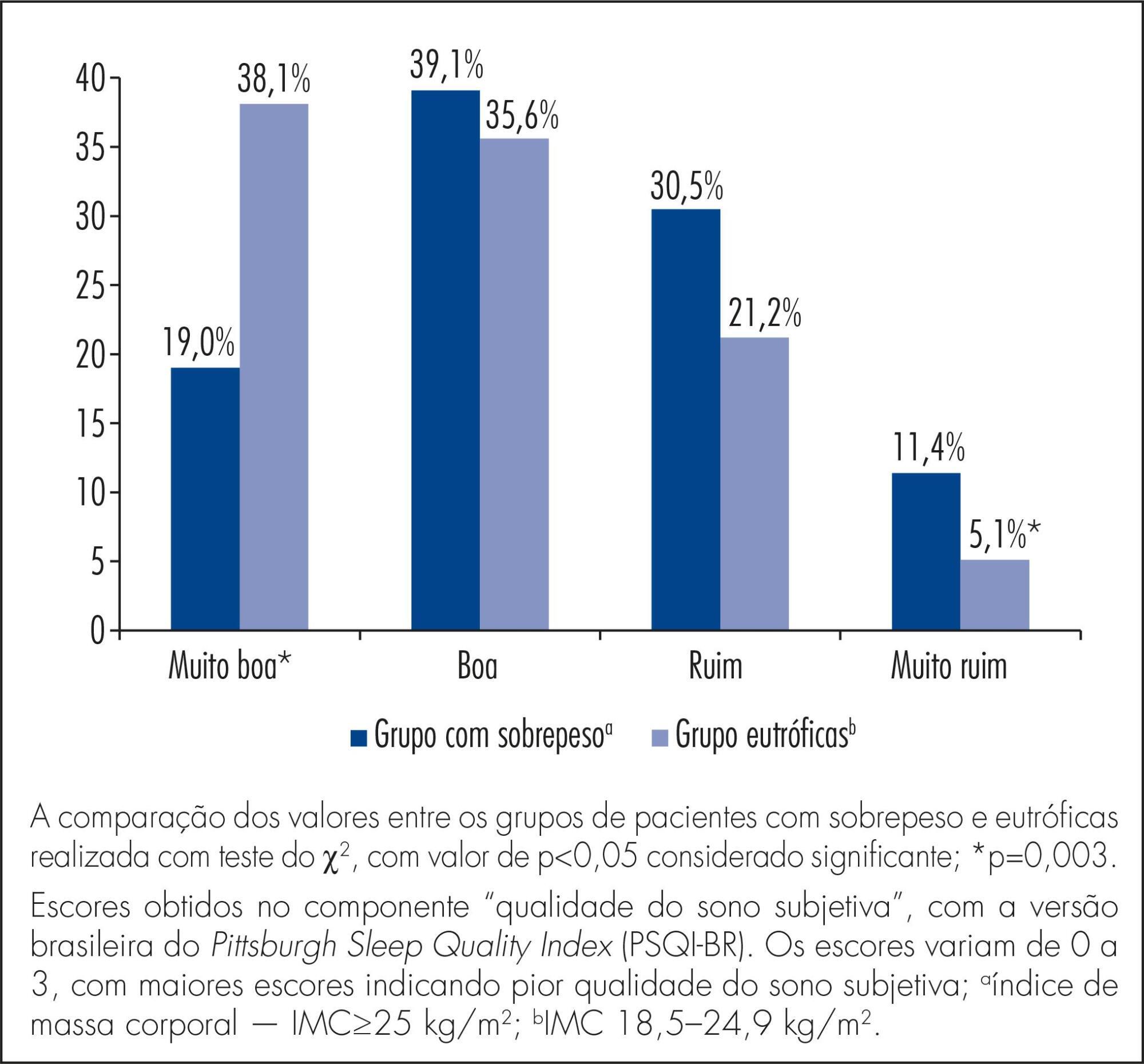Summary
Revista Brasileira de Ginecologia e Obstetrícia. 2018;40(4):180-187
To assess the effectiveness of metformin in the incidence of gestational diabetes mellitus (GDM) in obese pregnant women attending a public maternity hospital in Joinville, Santa Catarina, Brazil.
Randomized clinical trial including obese pregnant women with a body mass index (BMI) ≥ 30 kg/m2, divided into two groups (control and metformin). Both groups received guidance regarding diet and physical exercise. The participants were assessed at two moments, the first at enrollment (gestational age ≤ 20) and the second at gestational weeks 24-28. The outcomes assessed were BMI and gestational diabetes mellitus (GDM) diagnosis. The data distribution was assessed with the Friedman test. For all the analytical models, the p-values were considered significant when lower than 0.05. The absolute risk reduction was also estimated.
Overall, 164 pregnant women were assessed and further divided into 82 participants per group. No significant difference was observed in BMI variation between the control and metformin groups (0.9 ± 1.2 versus 1.0 ± 0.9, respectively, p = 0.63). Gestational diabetes mellitus was diagnosed in 15.9% (n = 13) of the patients allocated to the metformin group and 19.5% (n = 16) of those in the control group (p = 0.683). The absolute risk reduction was 3.6 (95% confidence interval 8.0- 15.32) in the group treated with metformin, which was not significant.
Metformin was not effective in reducing BMI and preventing GDM in obese pregnant women.

Summary
Revista Brasileira de Ginecologia e Obstetrícia. 2018;40(1):11-19
To evaluate the relation between changes the body mass index (BMI) percentile, reflected in the Atalah curve, and perinatal outcomes.
A cross-sectional study with 1,279 women was performed. Data regarding gestational weight, sociodemographic characteristics and perinatal outcomes were collected through medical charts, prenatal card and interviews in the postpartum period. Women could be classified according to the Atalah curve in the following categories: low weight, adequateweight, overweight, and obese. The BMIwas calculated at the first and at the last prenatal care visits, and these values were compared.
An increase in the BMI category according to the Atalah classification occurred in 19.9% of pregnant women, and an increase of 3.4, 5.8 and 6.4 points of BMI were found for women respectively classified in the adequate weight, overweight and obese categories at the first prenatal visit. Women with high school education presented a lower chance of increasing their BMI (odds ratio [OR] 0:47 [0.24- 0.95]). Women who evolved with an increase in the the Atalah classification were associated with cesarean section (OR 1.97-2.28), fetalmacrosomia (OR 4.13-12.54) and large for gestational age newborn (OR 2.88-9.83).
Pregnant women who gained enough weight to move up in their BMI classification according to the Atalah curve had a higher chance of cesarean section and macrosomia. Women classified as obese, according to the Atalah curve, at the first prenatal visit had a high chance of cesarean section and delivering a large for gestational age newborn.

Summary
Revista Brasileira de Ginecologia e Obstetrícia. 2017;39(12):692-696
To evaluate the effects of nutritional counseling on the dietary habits and anthropometric parameters of overweight and obese adolescentswith polycystic ovary syndrome (PCOS).
This was a prospective, longitudinal and auto-controlled study. Thirty adolescents aged 13-19 years-old, diagnosed with PCOS received nutritional counseling and were followed-up for 6 months. After the follow-up period, the results were evaluated through body weight, body mass index (BMI) and waist circumference (WC).
Sixty-percent of the adolescents adhered to the nutritional counseling and, of these, 50% lost weight. Adolescents who lost weight changed their dietary habits by adopting hypocaloric diets and eating more meals per day, as per nutritional counseling. The waist circumference (WC) decreased significantly, although the body weight decreased non-significantly after adoption of a hypocaloric diet.
Although there was no significant weight loss, there was a considerable reduction in theWCassociated with hypocaloric diets and with eating a greater number of meals per day.
Summary
Revista Brasileira de Ginecologia e Obstetrícia. 2017;39(7):330-336
To assess the impact of pre-pregnancy obesity (body mass index [BMI] ≥30 kg/m2) on the gestational and perinatal outcomes.
Retrospective cohort study of 731 pregnant women with a BMI ≥30 kg/m2 at the first prenatal care visit, comparing them with 3,161 women with a BMI between 18.5 kg/m2 and 24.9 kg/m2. Maternal and neonatal variables were assessed. Statistical analyses reporting the demographic features of the pregnant women (obese and normal) were performed with descriptive statistics followed by two-sided independent Student’s t tests for the continuous variables, and the chi-squared (χ2) test, or Fisher’s exact test, for the categorical variables. We performed a multiple linear regression analysis of newborn body weight based on the mother’s BMI, adjusted by maternal age, hyperglycemic disorders, hypertensive disorders, and cesarean deliveries to analyze the relationships among these variables. All analyses were performed with the R (R Foundation for Statistical Computing, Vienna, Austria) for Windows software, version 3.1.0. A value of p < 0.05 was considered statistically significant.
Obesity was associated with older age [OR 9.8 (7.8-12.2); p < 0.01], hyperglycemic disorders [OR 6.5 (4.8-8.9); p < 0.01], hypertensive disorders [OR 7.6 (6.1-9.5); p < 0.01], caesarean deliveries [OR 2.5 (2.1-3.0); p < 0.01], fetal macrosomia [OR 2.9 (2.3-3.6); p < 0.01] and umbilical cord pH [OR 2.1 (1.4-2.9); p < 0.01). Conversely, no association was observed with the duration of labor, bleeding during labor, Apgar scores at 1 and 5 minutes after birth, gestational age, stillbirth and early neonatal mortality, congenital malformations, and maternal and fetal injury.
We observed that pre-pregnancy obesity was associated with maternal age, hyperglycemic disorders, hypertension syndrome, cesarean deliveries, fetal macrosomia, and fetal acidosis.

Summary
Revista Brasileira de Ginecologia e Obstetrícia. 2015;37(8):359-365
DOI 10.1590/SO100-720320150005415
To compare sleep quality of overweight versus normal weight women in the second and third trimesters of pregnancy.
A cross-sectional study involving 223 women with 14 or more weeks of pregnancy, 105 of them overweight (pre-pregnancy body mass index - BMI - ≥25.0 kg/m2) and 118 of normal weight (BMI 18.5-24.9 kg/m2), attending the prenatal care clinic. The Brazilian version of the Pittsburgh Sleep Quality Index (PSQI-BR) questionnaire was used to evaluate sleep quality. The Student t-test and the chi-square test were used to compare differences between groups and a p value <0.05 was considered statistically significant.
Most of the participants (67.7%) were poor sleepers (total score >5); this proportion was significantly higher among overweight (80/105) versus normal weight (67/118) women (76.2 versus 56.8%, p=0,004). During the second trimester, this difference did not reach statistical significance (72.5 versus 53.7%, respectively, p=0.06) but mean total PSQI-BR scores were significantly higher among overweight participants (7.0±3.8 versus 5.5±3.2, p=0.02). In the 2nd trimester, overweight women also had higher scores for sleep latency (1.4±1.0 versus 1.0±0.9, p=0.02) and subjective sleep quality (1.3±0.8 versus 0.8±0.8, p=0.02). In the third trimester, the proportion of women with poor sleep quality was significantly higher in the overweight group, but did not reach statistical significance (79.6 versus 60.8%, p=0.06). During this period, total mean scores were similar for women with and without excess weight (9.4±4.2 versus 8.3±4.6, p=0.2). However, overweight women had higher mean scores for sleep disturbance (2.3±0.7 versus 2.0±0.8, p=0.04).
Overweight women had a poorer sleep quality than normal weight women in the second and third trimesters of pregnancy.

Summary
Revista Brasileira de Ginecologia e Obstetrícia. 2015;37(7):302-307
DOI 10.1590/S0100-720320150005352
To evaluate the follicular development of female Wistar rats with obesity induced by the cafeteria diet, submitted to the administration of losartan (LOS), an antagonist of the AT1 receptor of Angiotensin II.
At weaning (21 days of age), female Wistar rats were randomly divided, into two groups: control (CTL) that received standard chow and cafeteria (CAF) that received a cafeteria diet, a highly palatable and highly caloric diet. At 70 days of age, at the beginning of the reproductive age, animals of the CAF group were subdivided into two groups (n=15/group): CAF, that received water, and CAF+LOS, that received LOS for 30 days. The CTL group also received water by gavage. At 100 days of age, the animals were euthanized and body weight (BW) as well as the retroperitoneal, perigonadal and subcutaneous fat weights were analyzed. The right ovaries were isolated for counting the number of primary, secondary, antral and mature follicles. Plasma levels of FSH, LH, prolactin and progesterone hormones were analyzed. The results were expressed as mean±standard error of the mean. Data were analyzed statistically by one-way ANOVA followed by the Newman-Keuls post-test (p<0.05).
BW and fat weight, as well as the number of antral follicles, were higher in the CAF group compared to the CTL group. However, FSH and LH levels were lower in CAF animals compared to CTL animals. LOS administration attenuated the reduction of FSH and LH levels. Progesterone and PRL levels were similar among groups.
LOS could improve follicular development in obese females and could be used as an adjunctive drug in the treatment of infertility associated with obesity.

Summary
Revista Brasileira de Ginecologia e Obstetrícia. 2015;37(4):164-171
DOI 10.1590/SO100-720320150005186
To identify the factors associated with weight retention after pregnancy.
A cohort study was performed with 145 women receiving maternity care at a hospital in Caxias do Sul, Rio Grande do Sul, Brazil, aged 19 to 45 years, between weeks 38 and 42 of pregnancy. The patients were evaluated at one month, three months, and six months after delivery. Student's t-test or one-way analysis of variance (ANOVA) was used to compare groups, as indicated; correlations were assessed with Pearson's and Spearman's tests, as indicated; to identify and evaluate confounders independently associated with total weight loss, a multivariate linear regression analysis was performed and statistical significance was set at p≤0.05.
There was a significant positive association between total weight gain - and a negative association with physical exercise during pregnancy - with total weight loss. Higher parity, inter-pregnancy interval, calorie intake, pre-pregnancy body mass index (BMI), weight gain related to pre-pregnancy BMI, presence and severity of depression, and lack of exclusive breastfeeding were directly associated with lower weight loss. Among nominal variables, level of education and marital status were significantly associated with total weight loss.
In the present study, lower weight retention in the postpartum period was associated with higher educational attainment and with being married. Normal or below-normal pre-pregnancy BMI, physical activity and adequate weight gain during pregnancy, lower parity, exclusive breastfeeding for a longer period, appropriate or low calorie intake, and absence of depression were also determinants of reduced weight retention.

Summary
Revista Brasileira de Ginecologia e Obstetrícia. 2014;36(11):503-508
DOI 10.1590/S0100-720320140005081
To evaluate variations in the body mass index in patients undergoing adjuvant chemotherapy for breast cancer, and to associate these changes with patient's age and adjuvant chemotherapy regimen.
We performed a retrospective cohort study in order to correlate any variation in the body mass index before and after adjuvant chemotherapy with patient's age and adjuvant chemotherapy regimen. Patients who received any form of prior hormone therapy, such as tamoxifen or aromatase inhibitors, were excluded. We selected data for 196 patients with stage I to III breast cancer who were treated by radical or conservative surgery and received adjuvant chemotherapy at the Cancer Institute of the State of São Paulo, Brazil.
Before adjuvant chemotherapy, 67.8% of patients were classified as overweight or obese according to their body mass indices. Around 66.3% (95% CI 59.7–73.0) of the patients exhibited an increase in the body mass index after adjuvant chemotherapy. The average age of all patients was 56.3±11.3 years. Participants whose body mass index increased were younger than those with no increase (54.7±11.1 versus 59.3±11.2 years; p=0.007). Patients were treated with the following adjuvant chemotherapy regimens: doxorubicin, cyclophosphamide, and paclitaxel (AC-T, 129 patients, 65.8%); 5-fluoracil, doxorubicin, and cyclophosphamide (36 patients, 18.4%); cyclophosphamide, methotrexate, and 5-fluoracil (16 patients, 8.2%); docetaxel and cyclophosphamide (7 patients, 3.6%); and other regimen (8 patients, 4.1%). The AC-T regimen showed a statistically significant association with increase in the body mass index (p<0.001 by ANOVA).
Most patients with breast cancer showed an increase in the body mass index after adjuvant chemotherapy, especially after the AC-T chemotherapy regimen.